Red Sonja: The Novels
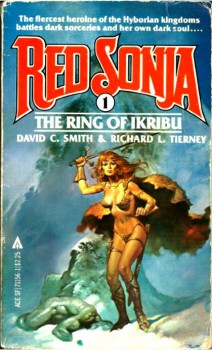 In late 1981, Red Sonja finished her orbit from Robert E. Howard character to Conan supporting cast member to comic book heroine and back to text. Writers David C. Smith and Richard L. Tierney were commissioned to write six Red Sonja novels. Their take on the character was uniquely their own, yet there’s enough of the character’s trademarks to leave no doubt these are Red Sonja novels and not just generic adventure tales with a recognizable name pasted over them.
In late 1981, Red Sonja finished her orbit from Robert E. Howard character to Conan supporting cast member to comic book heroine and back to text. Writers David C. Smith and Richard L. Tierney were commissioned to write six Red Sonja novels. Their take on the character was uniquely their own, yet there’s enough of the character’s trademarks to leave no doubt these are Red Sonja novels and not just generic adventure tales with a recognizable name pasted over them.
The series began with The Ring of Ikribu, first published in December 1981. After a brief introduction by Roy Thomas (wherein the origins of the character are explained), the story opens with Asroth (an evil wizard) chewing out one of his lieutenants for failing to locate the titular ring. As punishment, he magically rearranges the lieutenant’s face into some sort of Lovecraftian unspeakable horror. Shifting locations, we learn that Asroth has seized the kingdom of Suthad with an army of ghosts. The ousted king, Olin, is gathering a mercenary army to take back Suthad and Red Sonja is one of those mercenaries. Also amongst the mercenaries is Duke Pelides, the aforementioned lieutenant who is now forced to wear a mask at all times. Olin wants the return of his kingdom, Pelides wants revenge, and Sonja just wants to get paid. Of course, as is the way with Sonja, she slowly becomes emotionally invested in those around her and eventually the money ceases to be her driving motivation. In less than two-hundred and fifty pages, the novel does a good job of conveying the sense of a long, grueling campaign without actually become monotonous.
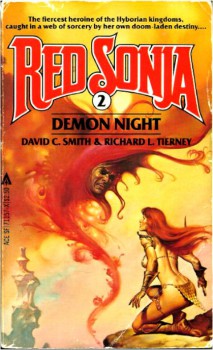 Demon Night is the next volume, published in March 1982. Sonja flees a mercenary group after being falsely accused of murdering the chief. The new leader (and true killer of his predecessor), Keldum, gives chase across the desert. They all find themselves in the remote outpost of Elkad, where the people still practice hideous sacrificial rites to appease the demons that surround them. Of course, the sight of hanging women who were clearly tortured to death, just outside the outpost’s gate, would probably keep most humans away as well. Sonja gets caught up in a power struggle between Keldum and Hefei, the mistress of Elkad, that ends with her fleeing to the nearby mountains to meet Saureb, a pacifist hermit. Along the way, she also meets Tiamu, a young acolyte who is next in line to be tortured for the demon hordes. The story takes a turn as we discover how, far from being a threat, the demons are essential to the government’s continued control of the outpost, to the point where it’s suggested that maybe there aren’t any demons at all, as the idea of demons would generate as much fearful obedience as actual unseen ones.
Demon Night is the next volume, published in March 1982. Sonja flees a mercenary group after being falsely accused of murdering the chief. The new leader (and true killer of his predecessor), Keldum, gives chase across the desert. They all find themselves in the remote outpost of Elkad, where the people still practice hideous sacrificial rites to appease the demons that surround them. Of course, the sight of hanging women who were clearly tortured to death, just outside the outpost’s gate, would probably keep most humans away as well. Sonja gets caught up in a power struggle between Keldum and Hefei, the mistress of Elkad, that ends with her fleeing to the nearby mountains to meet Saureb, a pacifist hermit. Along the way, she also meets Tiamu, a young acolyte who is next in line to be tortured for the demon hordes. The story takes a turn as we discover how, far from being a threat, the demons are essential to the government’s continued control of the outpost, to the point where it’s suggested that maybe there aren’t any demons at all, as the idea of demons would generate as much fearful obedience as actual unseen ones.
When Hell Laughs, published in June 1982 (When did these two sleep?), centers on the island prison of Os Harku. There’s been an uprising among the prisoners, who organize with a two-fold plan of escaping the island and exacting revenge against the government officials who placed them there. The plan comes together better than expected (for the prisoners) when the ship they overtake happens to be hosting several of the above-mentioned officials. Also on board is Red Sonja, who briefly acts as the common enemy for Urdus (the uprising’s leader) and Athu (a Shemite sorceror). As the story moves on, the hatred of the two prisoners for eachother overpowers their apprehension towards Sonja and the other soldiers. This one has a nice dialogue between Red Sonja and an incredulous ogler concerning the practicality of her trademark bikini.
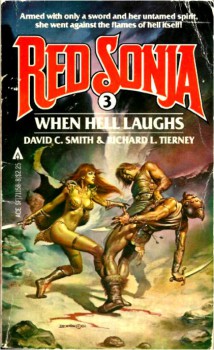 Next up is Endithor’s Daughter, first published in October 1982. It opens with Endithor, a nobleman, being caught in an act of sorcery (involving human sacrifice, no less) and arrested. He was working with Count Nalor to rid Shadizar of a supernatural enemy. Once Nalor betrays Endithor to throw in with the supernatural threat, it’s a short trial followed by death via slow public torture. His daughter, Areel, knows the truth, however, and vows revenge. It’s rather alarming how easily one picks up the sorcerous arts, because Areel’s raising zombie slaves like a pro in a matter of weeks. Of course, the supernatural evil allied with Nalor is both a wizard and a vampire named Kus, so it’s not going to be enough. And how does Red Sonja get involved? She’s just sleeping next door to the rented room where Areel keeps her magic junk and wakes up one night to investigate a noise. There’s a wonderfully tense scene near the end of this novel where Red Sonja has to quietly wait until sunrise, never certain if she’ll survive that long.
Next up is Endithor’s Daughter, first published in October 1982. It opens with Endithor, a nobleman, being caught in an act of sorcery (involving human sacrifice, no less) and arrested. He was working with Count Nalor to rid Shadizar of a supernatural enemy. Once Nalor betrays Endithor to throw in with the supernatural threat, it’s a short trial followed by death via slow public torture. His daughter, Areel, knows the truth, however, and vows revenge. It’s rather alarming how easily one picks up the sorcerous arts, because Areel’s raising zombie slaves like a pro in a matter of weeks. Of course, the supernatural evil allied with Nalor is both a wizard and a vampire named Kus, so it’s not going to be enough. And how does Red Sonja get involved? She’s just sleeping next door to the rented room where Areel keeps her magic junk and wakes up one night to investigate a noise. There’s a wonderfully tense scene near the end of this novel where Red Sonja has to quietly wait until sunrise, never certain if she’ll survive that long.
Then we have Against the Prince of Hell, published in February 1983. It opens with an unconscious Red Sonja being taken in by a band of soldiers. When she awakens, she discovers that she’s been sick with mountain fever and that the soldiers have nursed her to health. Feeling a debt to the soldiers, she agrees to help their leader, Omeron, the deposed lord of Thresrad, regain his kingdom. It seems that Omeron was betrayed by his wife, Yarise, who gave the evil wizard Du-jum a foothold into the kingdom. Despite what you might first guess from the cover, the giant snake in this case is actually a good guy, the sorceress Ilura in her animal form. Of course, “good guy” is a subjective term as Omeron (much like Olin in The Ring of Ikribu) has to seek justice with the help of men and women more concerned with vengeance than good or evil.
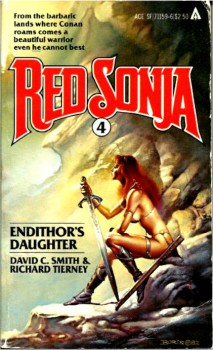 And, finally, Star of Doom, first published May 1983, begins with a meteor crashing just east of Brythunia. This results in a war between the priesthood who bring the meteor back to their ziggaurat temple and the forest people who believe it to be evil. The high priest, Thotas, slowly learns the nature of the meteor’s power while the forest people are repelled time and again by supernatural attacks. Red Sonja is fighting alongside the forest people and goes off with Daron (a man with a secret past) to find some means to fight magic with magic. There’s swamp zombies and an attempt to show a man reaching Sonja’s heart through non-combative means.
And, finally, Star of Doom, first published May 1983, begins with a meteor crashing just east of Brythunia. This results in a war between the priesthood who bring the meteor back to their ziggaurat temple and the forest people who believe it to be evil. The high priest, Thotas, slowly learns the nature of the meteor’s power while the forest people are repelled time and again by supernatural attacks. Red Sonja is fighting alongside the forest people and goes off with Daron (a man with a secret past) to find some means to fight magic with magic. There’s swamp zombies and an attempt to show a man reaching Sonja’s heart through non-combative means.
Perhaps the greatest distinction between these novels and the comics that came before them is that Red Sonja is here depicted as much more of a team player. The novels each have multiple plotlines with multiple points of view, of which Sonja is only one. In fact, it’s rare that the decisive action comes by her hand, although her influence is always present. We see Red Sonja more as a catalyst for adventure rather than a straight protagonist, inspiring others to greatness. I’m not clear on how the actual timeline of comics vs. novels works, but Smith and Tierney’s Sonja seems older, more world-weary, but also more willing to assume the mantle of leadership if necessary.
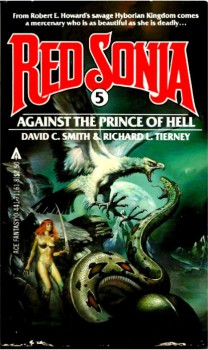 Another key difference is the absence of absurdity. These novels are much more serious than the Roy Thomas insanity of giant clams and bee people, much more in line with the feel of Robert E. Howard’s worldview. While magic is part of this world, it doesn’t eat the scenery like in the comics.
Another key difference is the absence of absurdity. These novels are much more serious than the Roy Thomas insanity of giant clams and bee people, much more in line with the feel of Robert E. Howard’s worldview. While magic is part of this world, it doesn’t eat the scenery like in the comics.
Besides the chain mail bikini, the other uniquely Red Sonja quality that stays in the novels is her vow. Here it’s played not as a rape analogy, but as an extreme courting ritual. Of course, none of the suitors succeed; but the fights are always tinged with a sadness. Sonja fights them because of an oath and takes no pleasure in their defeat. It’s kind of like the hot girl at the bar that every guy hits on: she doesn’t hate men, but she feels sorry for every one who approaches her because she knows they don’t have a chance. Strangely, it’s also implied several times that the divine vision, wherein Sonja swore her oath, was possibly a hallucination. Furthermore, Sonja suspects it was a hallucination, so on some level realizes that her sacred oath was made only to herself and no one else.
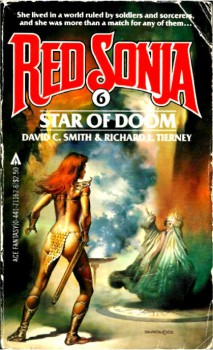 Of course, being eighties fantasy, the cover art was going to be a huge part of it and these six novels don’t disappoint in that regard. Every one of them sports a cover painting by no one less than Boris Vallejo (who’d previously painted Red Sonja for the cover of Savage Sword of Conan 1). It’s hard for me to narrow down my favorite of the six, although probably book four (Endithor’s Daughter) wins out for being just the most straight-up beautiful. Sonja is sitting alone on a rocky crag, sword in hand but at rest, she’s staring off in quiet contemplation. A close second would be book two (Demon Night), with our heroine crouched on the edge of a cliff, ready to pounce on a smoke demon. If you’ve never seen the work of Boris Vallejo before… welcome to Earth. Go check out the website of Vallejo and his wife (and fellow legendary fantasy artist) Julie Bell.
Of course, being eighties fantasy, the cover art was going to be a huge part of it and these six novels don’t disappoint in that regard. Every one of them sports a cover painting by no one less than Boris Vallejo (who’d previously painted Red Sonja for the cover of Savage Sword of Conan 1). It’s hard for me to narrow down my favorite of the six, although probably book four (Endithor’s Daughter) wins out for being just the most straight-up beautiful. Sonja is sitting alone on a rocky crag, sword in hand but at rest, she’s staring off in quiet contemplation. A close second would be book two (Demon Night), with our heroine crouched on the edge of a cliff, ready to pounce on a smoke demon. If you’ve never seen the work of Boris Vallejo before… welcome to Earth. Go check out the website of Vallejo and his wife (and fellow legendary fantasy artist) Julie Bell.
David C. Smith had previously written Oron in 1978, as well as a series of novels, novellas, and short stories set in the fictional island kingdom of Attluma. Besides the six Red Sonja novels, his other Robert E. Howard pastiches include The Witch of the Indies and For the Witch of the Mists. He’s still an active writer today (as regular readers of Black Gate are no doubt aware) and has recently released two novels: Dark Muse (from Damnation Books) and Waters of Darkness (co-authored by Joe Bonadonna), the latter of which features a strangely familiar pirate by the name of Crimson Kate O’Toole. You can read an interview conducted by Jill Elaine Hughes or check out his blog.
Richard L. Tierney has been writing Lovecraftiana and weird poetry since the 1970s. His latest works are The Drums of Chaos and Savage Menace and Other Poems of Horror.
Next Week: Can Red Sonja get too silly? Hollywood said, “No.”
Penkas! Penkas! Penkas!
Great article and review of the books, Mike. Thank you for mentioning me, and my collaboration with Dave on Waters of Darkness.
I used to have these books, loaned them out, and never got them back. Seeing this brings back a ton of memories. It also reminds me that the same guy I loaned them to also took me for the first 8 or 9 Horseclans books as well, all in one doomed, now lamented, paper grocery sack. The horror!
I recently made an effort to get all these books … am reading the 3rd book now and I have enjoyed what I have read so far …
I read a bunch of those Horseclans books years ago and really dug them. I seem to have misplaced or loaned out mine as well. I wonder how they hold up to re-reading?
I remember liking the first eight or ten Horseclans books, at least. It looks like the first few are on Kindle now with really horrific covers.
(Yet another series that I came to because of a review in Dragon magazine — as I think back, Dragon reviews were hugely important in shaping what I read in the early 1980’s.)
To Joe H.:
Ditto. Much of my reading in the 80s was due to either Dragon Magazine or some other TSR product at the time. For example, I was first introduced to the world and works of H. P. Lovecraft, Michael Moorcock, and Fritz Leiber because of the early Deities and Demigods manual. Good stuff!
Also not sure if I should admit this, but I spent much of my youth pronouncing her name SON-jah (with J like in Jet) instead of Sonia. In my defense, I think it makes for a perfectly acceptable sword & sorcery heroine name.
Mike, you captured perfectly what we were doing with these novels. Excellent article. The Boris covers really brought in the readers, and once the books got going, they had a big audience. I still have letters written to me by young women in the early 80s who were pleased with the way we portrayed Sonja and took her as a kind of role model (without the swordplay, I’m assuming!). Making Sonja the focal point of the stories without putting her out front in a purely linear or masculine manner the way s&s usually was done was intentional because we wanted her to be a strong woman and a strong character without simply being another s&s character, ie, a tough guy with boobs. So there is that feminine perspective or insight to her balanced with whatever testoserone she had going on. The world weariness is, I think, the way Dick and I see the world of these stories. It’s just part of how we write s&s.
To Joe H and mcglothlin:
Same here on the TSR influence. That, and the “Suggested Reading” list from the 1st Edition DM’s Guide.
[…] Red Sonja: The Novels […]
[…] published an excerpt back in March. And just a few months ago our website editor, Michael Penkas, reviewed his much-loved Red Sonja novels, co-written with Richard L. Tierney in the early […]
[…] astounding gracious to two young sword & sorcery fans, entertaining us with tales of writing Red Sonja novels with Richard L. Tierney and the wild S&S publishing scene in the […]
[…] Red Sonja Prose Novels at BlackGate: http://www.blackgate.com/2013/04/09/red-sonja-the-novels/ […]